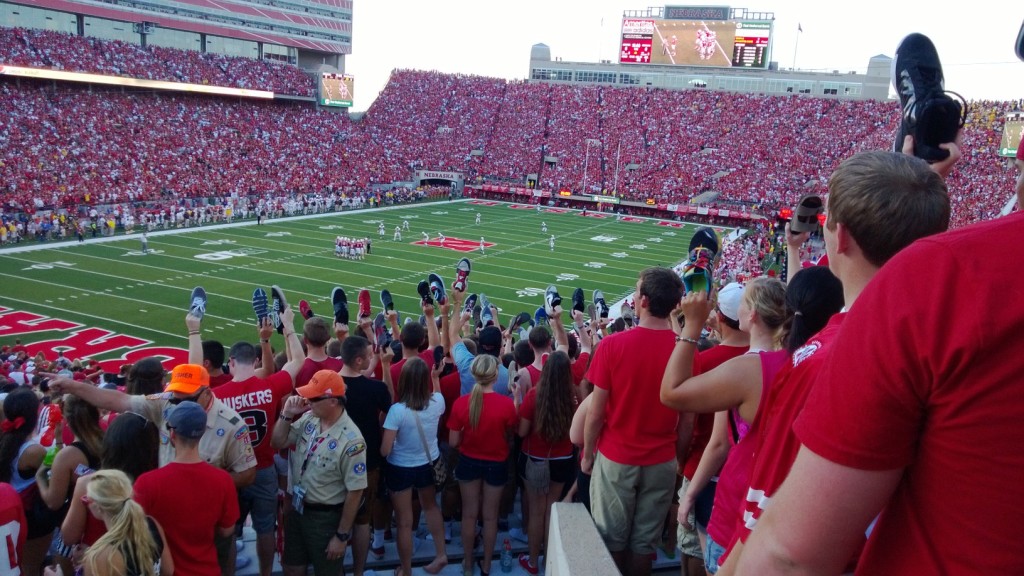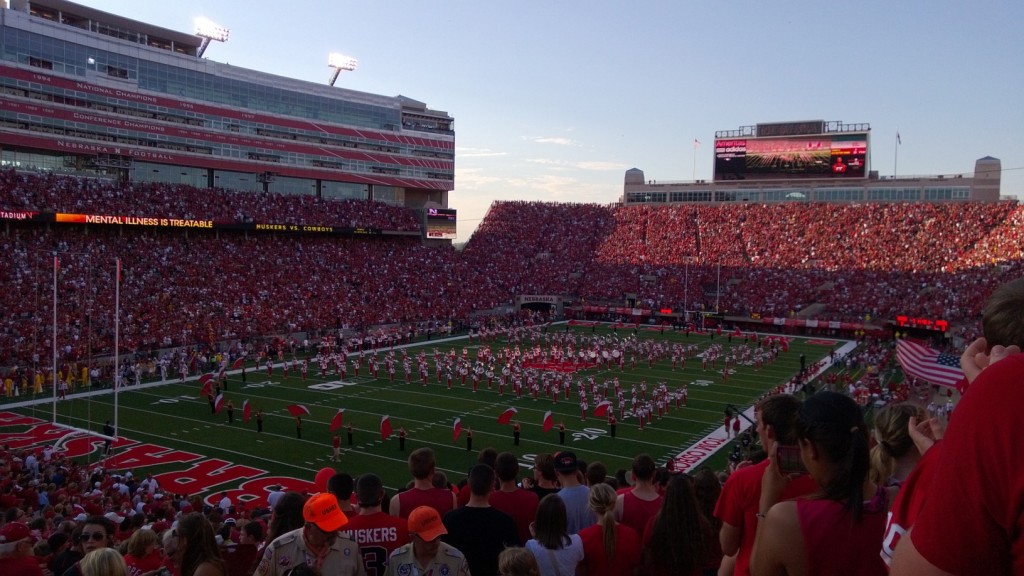This is the third of a three-part series of Savvy Saturday articles where I discuss attending a cultural event here in Lincoln, NE as if it took place in a fantasy world. To see my thoughts on the preparations and background of the “Gobi Gred” ceremony, check out part 1. To see my evaluation of the setting and participants of the ceremony, check out part 2.
Sitting in the student section of the Gobi Gred ceremony, I quickly found myself caught up in the energy and excitement of the crowd. While the most important action took place on the ritual battlefield below, where the cornhusker warriors battled their people’s ancient foes, the attendees were also kept busy with making the traditional verbal and nonverbal responses that accompanied the parts of the ceremony enacted before them.
Some of these responses appeared to be universally expected, as they were carried out by the majority of the 90,000 scarlet-clad attendees seated around me. Others appeared to be special duties assigned to those who sat in the student section. As a participant-observer, I took care to note both types, which shall be described in the following paragraphs.
At the beginning of the Gobi Gred ceremony, the musicians for the ’husker warriors play the official anthem of the nation in which the people of the land of the Good Life live. As is custom, those in attendance rise and sing along. However, the last phrase of the song – “the home of the brave” – is instead sung as “the home of the ’HUSKERS!” This cooptation of the tribal identity for the national identity, and the implied definition that it is the ’huskers who are the brave, set the proud, aggressive tone for the ceremony to come.
After the singing of the national anthem, the band of ’husker warriors is introduced. This introduction is accompanied by musical and visual aids featured on large screens set several strategic places around the sacred oval where the ceremony is held. These screens show in real-time, as if by magic, what is happening on the battlefield below. Throughout the ceremony, the screens are also used to display instructions to the attendees, to replay important moments from the ceremony for those who missed them, and to draw attention to what is happening in other places in the sacred oval. In this case, the screens allow each ’husker warrior to introduce himself – and give the attendees a chance to show their appreciation for the individuals who will represent them in the battle to come. This appreciation is shown by cheering, which echoes through the entire sacred oval in a roar of sound that drowns out whatever words are spoken by the warriors on the screens.
After the band of ’husker warriors – both offense and then the feared blackshirts – have been introduced, the screens show the warriors themselves. They are shown running through a long tunnel through which they will emerge onto the ritual battlefield; as they exit, each warrior jumps up to touch a sign bearing a good luck charm with the hopes it will lead them to victory. By the time they can be seen with the naked eye on the field below, the entire crowd of attenders is on their feet, cheering the warriors’ arrival.
Soon, someone begins the ritual call of the Gobi Gred, which will resound and echo throughout the sacred oval near-continuously until the ceremony’s end. “Gooooooobiiiiiiiiigreeeeeeeeed!” someone shouts, long and loud, and the response comes from everyone within hearing distance: “GOBI GRED!” This call and response pattern is repeated for a total of three exclamations.
The warriors quickly assemble on the field, ready to begin their ritual battle. In response, all those in the student section rise and remove one shoe. (From this moment on, all those with seats in the student section typically stand on their seats for the entire ceremony. For those in front, this offers a better view of the game. For those behind, standing on their seats is the only option to see over the heads of those in front of them.)
At this point, students then wave their shoe forward and back, encouraging the warriors to kick the ball well and far. At the same time, an invigorating rhythmic tune begins playing from the large screens around the sacred oval. This tune is played several times during the ceremony, and each time, the student section vocalizes along with it at the top of their lungs. At the end of the music, the ’husker warrior runs forward to the ball, while the students vocalize a long, loud note. This note ends when the warrior kicks the ball, at which point a guttural “oom!” is uttered by all the students – adding an appropriately forceful sound to an impressive visual event.
From that beginning, the battle rages on following certain types of patterns, each of which are associated with their own rituals. A good play from the ’husker warriors results in cheering and a rousing few notes from the ’husker musicians. (Similarly, the musicians of the opposing band of warriors play the beginning of their ritual music when they do well.)
When the ’huskers first reach the rectangular field at the end of the battleground, symbolically planting their seeds in the earth where they will grow into rich crops, the audience cheers wildly. Red globes filled with gas are released to float out over the sacred circle; these inform all those in the city not at the ceremony that the ’huskers have taken their first step toward victory. In addition, the musicians play the ritual music associated with the ’husker warriors: this is a song that everyone in attendance knows, as they clap in time to the rhythm, and at certain points in the music yell in unison, “Go ’huskers!”
Every time after this, when the ’huskers reach the symbolic cornfields with their seed in hand, the musicians play part of the ritual music, and the audience throw up their hands parallel to each other in a ceremonial symbol of victory. This is often followed by the attendees wiggling the fingers of their raised hands, indicating their eagerness to catch the ball as one of the ’husker warriors attempts to kick it through a tall metal rectangle on a pole at the far side of the battleground.
When it is the ’huskers’ opponents turn to attempt to score, the blackshirts are brought onto the field. Every time, their entrance is accompanied by menacing music. This is the cue for the student section to pound their wrists together, arms crossed, a ritual practice intended to strengthen the blackshirts and improve their ability to bring down their foes. In addition, the screens encourage all in attendance to “get loud,” to make noise, and to cheer for the ’huskers. This not only intimidates the warriors on the other side and encourages the blackshirts, it also provides very practical help to the ’huskers by making it too loud for the opposing team to strategize together on the battlefield.
At times throughout the ceremony, a yellow strip of cloth may be thrown onto to the battleground by the black and white clad rule-enforcers. This signals a rule violation. All in attendance stop and listen with bated breath, fearing to hear what the rule-enforcer has to say. If the man indicates that the ’huskers’ enemies are at fault, all those who support the land of the Good Life cheer. “Good call!” is heard throughout the sacred oval, as well as more aggressive comments, such as “Take that!” and “That’ll show them!”
When the enforcers assert that the ’huskers have been in violation, however, it is mandatory for the crowd to take offense. It is held as sacred truth that ’huskers will never break the rules of the ceremony; any call made against the ’huskers is clearly due to the stupidity and blindness of the rule-enforcers. By shouting enough insults and booing loudly enough, it is hoped by the crowd, the rule-enforcer will see the error of his ways and reverse his call.
It should be noted that this rarely works. Upon occasion, however, rule-enforcers will, indeed, review the decisions they have made and reverse them upon further review. These happenings contribute to the attendees’ beliefs that they do, in fact, help determine the outcome of the ceremony, and reinforces their commitment to making their pleasure or displeasure with the rule-enforcers known with every call.
Finally, every instance of the Gobi Gred ceremony requires the physical participation of its attendees in a massive visual display of solidarity. This unique ritual-within-a-ritual is looked forward to and embraced by attenders, who refer to its practice and completion as “the wave.” The wave is led by a ceremonial representative, who runs the length of the battlefield, encouraging attendees to stand up, raise their hands, and shout as he passes by. The result, once the representative has caught the attendees’ attention, is a “wave” of sight and sound that sweeps around the entire sacred oval and back again. Sometimes it can go two, three, or four times around before an event on the battlefield places the attention of all in attendance back on the exploits of their warriors.
Given that the land of the Good Life is landlocked, the origins of the oceanic reference are intriguing. Likely, the phrase comes from ancient travelers to distant coastlands who applied ocean imagery to the picture of cornfields blowing in the wind. Whatever its origins, the ritual is now an essential part of the Gobi Gred ceremony. By “doing the wave,” attendees represent the fields of corn that they hope to grow in the next year, and remind themselves and their warriors on the field of their identity as members of the cornhusker tribe.
While it requires a great deal of attention and a certain amount of training ahead of time to properly participate in the Gobi Gred ceremony, as can be seen from the descriptions above, attendees enjoy the work they do. Through their vocal and physical motions, they provide encouragement to their tribe’s warriors, they work to help their people achieve victory, and just as important, they affirm to themselves and each other their role as a valued part of the tribe of the land of the Good Life.
This affirmation is carried away from the sacred oval in the hearts of attendees even after the ceremony is successfully concluded. As participants file out, they reach up to the ceiling of the exit tunnel and touch the three-line tribal symbol painted there, in conscious mimicry of the actions of their warriors at the ritual’s start. Both inside and outside the sacred oval, the call and response of “Gobi Gred!” continues, echoing long into the night from the lips of men, women, and children clad in scarlet.
As you leave the sacred oval, the chant pulses in your bones, carrying with it the exultation of victory and the pride of knowing that you were part of something grand and great and powerful. You were a participant in the Gobi Gred ceremony, you are a member of the tribe of the ’huskers, and the memories and feelings that now dwell in your heart will bind you to these people and to the land of the Good Life into the future.
You can see, now, why even those who have left their homeland and settled far away still gather on festival days to watch the ceremony on screens in their homes. You can see why tribal members wear the emblems of the ’huskers on their clothes throughout the year. And now, whenever you hear the familiar ceremonial call in the distance, your lips curve up in a knowing smile, and you proudly reply, “Gobi Gred!”

